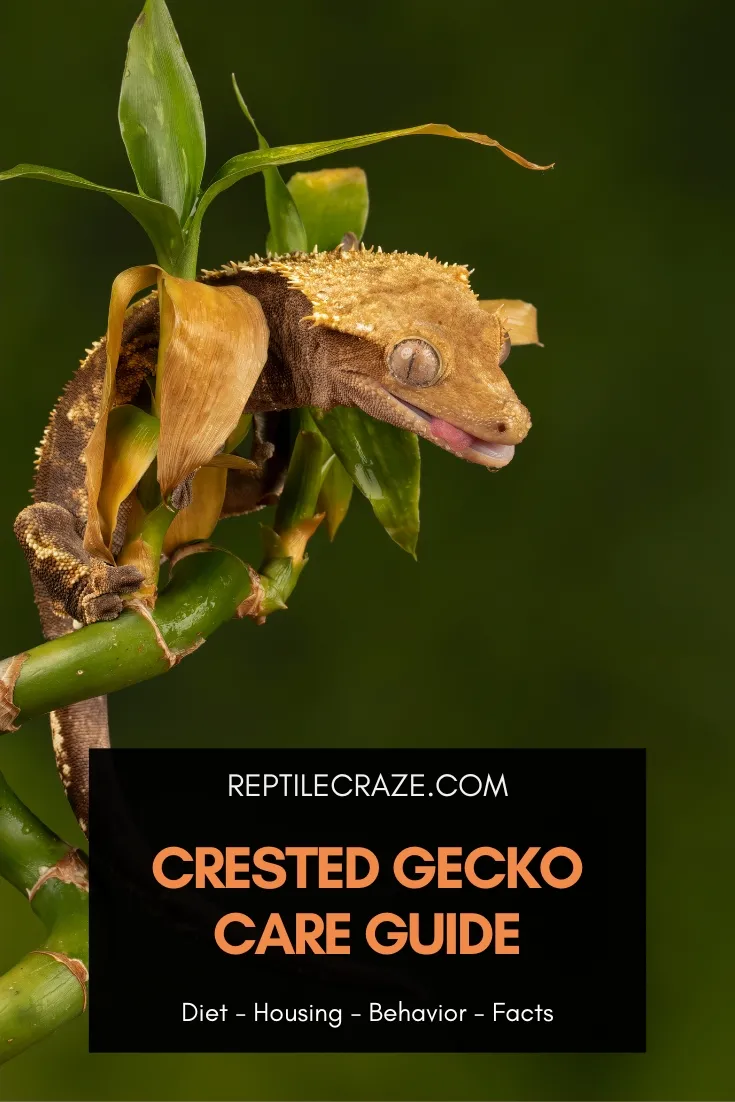
Are you considering getting a crested gecko? These unique animals are easy to care for and can make a perfect pet for beginners.
To make sure that your crested gecko gets the best possible care, it is important to first learn about how to properly look after them. This guide will provide you with the information that you will need to get you started.
Crested Geckos – The Facts
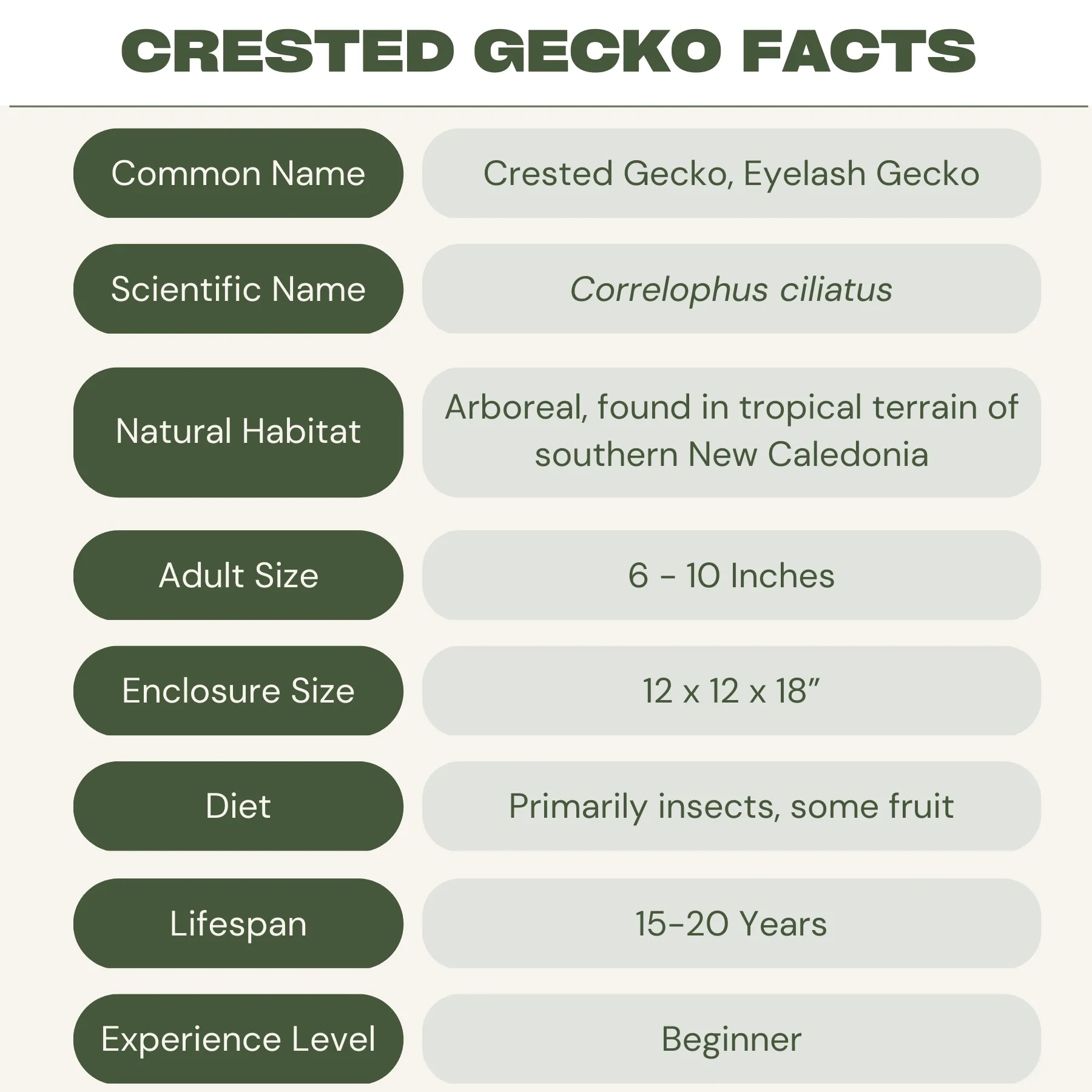
Where Do Crested Geckos Live?
The origin of the crested gecko is the southern tropical terrain of New Caledonia, a continental island group located in the southwest Pacific.
They are largely an arboreal species, living in the canopy of the rainforests in the South Province.
Crested Gecko Appearance, Colors, And Morphs
One of the most notable characteristics of crested geckos is their “eyelashes,” which appear as hair-like projections above both eyes.
They also have two rows of spines running from either side of their triangular head to the bottom of their tail.
Like all geckos, crested geckos do not have eyelids. Their eyes are protected by a clear membrane called a “spectacle” and they use their tongues to keep their eyes clean and moistened.
They also have the typical gecko semi-prehensile tail that helps with climbing and that can be dropped when threatened by predators.
The dropped tails do not grow back, and in the wild most crested geckos end up without a tail because of this.
The natural color of wild crested geckos tends towards browns and tans, to better blend in with their environments. Some variations have been reported, such as tiger striping or lighter fringes.
Captive crested geckos, on the other hand, have been bred to display a wide variety of unique patterns and colors.
There are many colors and shades of those colors; for example, brown geckos can range from a light tan color to almost black.
There are also a variety of patterns and different physical characteristics. These can combine in different colors to form a wide range of different morphs.
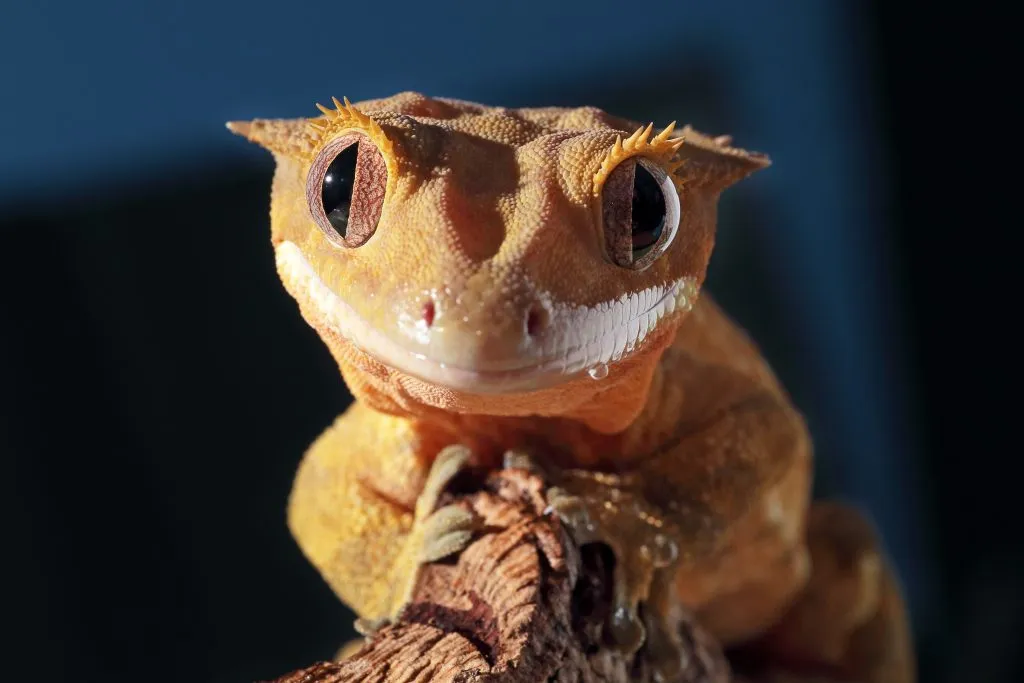
Color Variations
- brown
- green
- grey
- orange
- red
- white
- yellow
Pattern Variations
- bicolor
- brindle
- cheveron
- dalmation
- flame
- harlequin
- patternless
- pinstripe
- tiger
- tricolor
- white fringe
Physical Variations
- cactus
- crowned
- furry
- reverted
How Big Do Crested Geckos Get?
Crested geckos are one of the largest gecko species. They typically weigh between 1-2 grams and measure 2-3 inches in length at hatching.
They mature at around 12-18 months, reaching a length between 6-10 inches (including a 4-6 inch tail), and between 25–60 grams in weight. Females tend to be heavier than males when fully grown.
Crested Gecko Lifespan
Crested geckos kept in captivity are known to live for around 15 to 20 years, with some reported to live up to 25 years.
This species has only been raised in captivity for less than 30 years, so there has not yet been enough time to determine what the typical lifespan is for certain.
How To Care For Crested Geckos
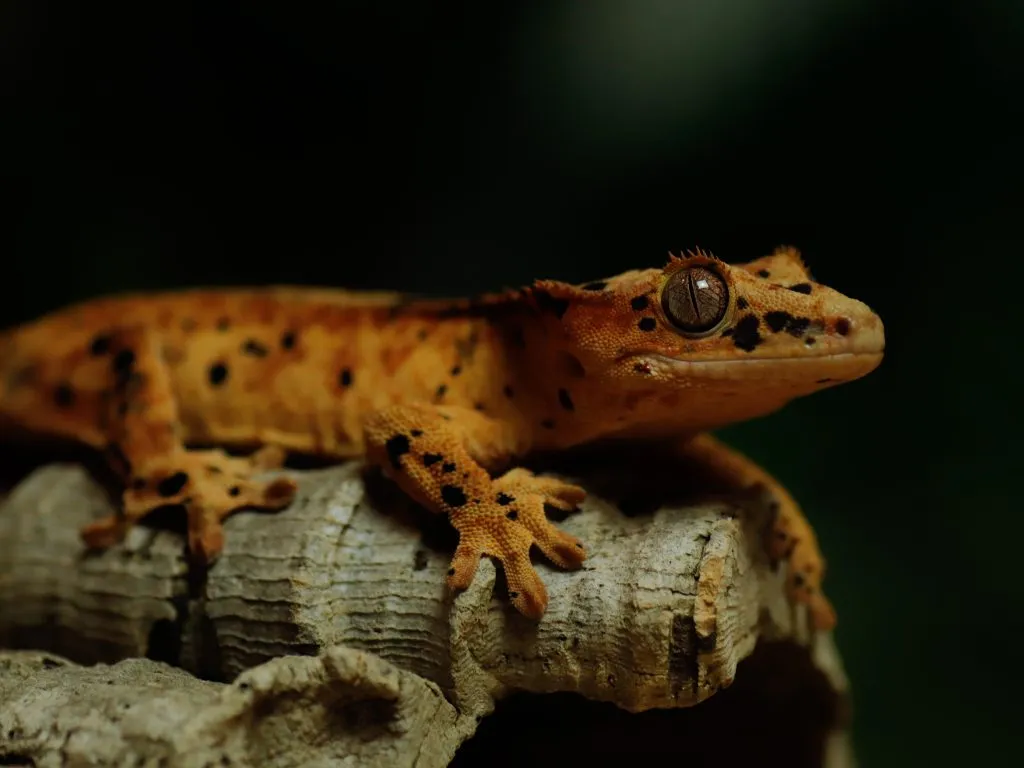
Crested Gecko Tank Setup
Habitats for crested geckos need to be high enough to accommodate their arboreal nature. This means tanks will usually be taller than they are wide.
A
Hatchlings are quite shy and tend to hide. You might consider a smaller
If you start off with a very small gecko and a very large enclosure, you may not see them again for a long time!
Temperature And Lighting
Crested geckos do not need high temperatures like some other reptiles. Their preferred temperature range is 72-78°F during the day, dropping to 69-74°F at night.
You will not need an additional heat source if your home stays within this range.
If you do need to add heat, you won’t need a lot. A smaller 25-watt halogen bulb will be sufficient in most situations. You can read more about heat lamps for crested geckos in our article here.
Crested geckos get stressed if they are too hot. If your home is often above 78°F, you probably should not get a crested gecko.
When it comes to lighting, crested geckos do not have any special lighting requirements. The natural lighting in your home is usually sufficient. They definitely do not need light at night, since they are a nocturnal species.
Click here to learn more about crested gecko lighting needs.
Do Crested Geckos Need UVB?
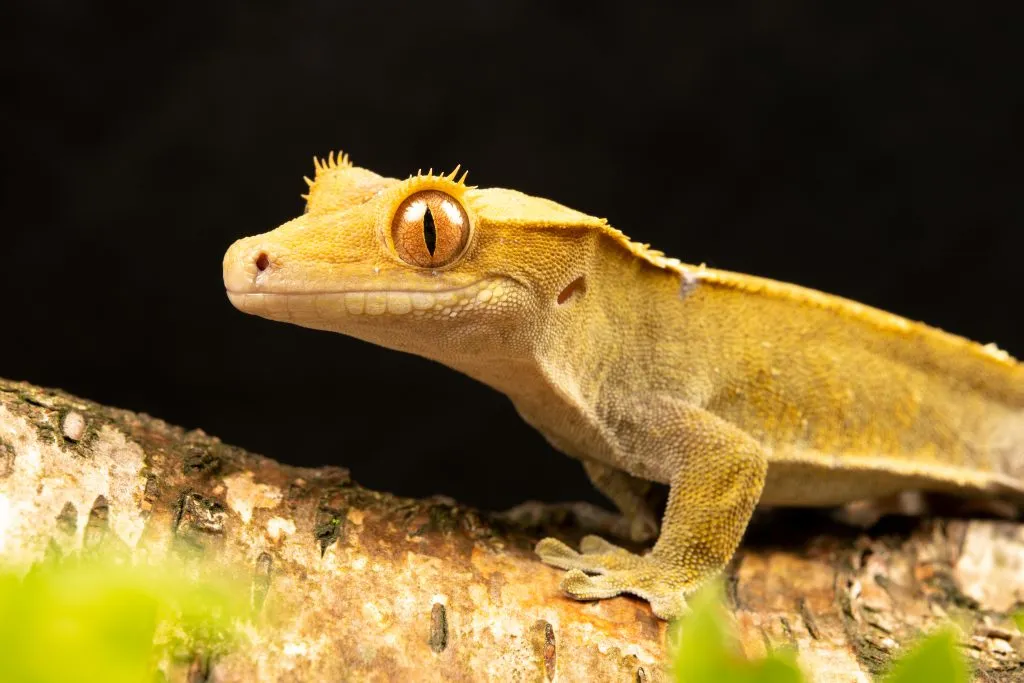
The answer to this question is no, crested geckos do not need a UVB light. UVB light is part of the spectrum of natural sunlight and, since geckos are not active during the day, they have evolved without the need for substantial UVB light exposure.
Substrate
Although crested geckos are arboreal and will spend most of their time off the ground,
This will provide an appropriate ground surface when they do come down. A good substrate also helps control the humidity levels in the
Coco fiber is often recommended; however, some owners believe that it causes impactions and should be avoided. Sphagnum moss is a popular substrate for crested gecko habitats but, by itself, may be prone to drying out quickly.
We recommend a mixture of two parts Exo Terra Plantation Soil and one part sphagnum moss. This creates a substrate suitable for tropical vivariums that holds moisture well.
If you want a substrate that doesn’t need to be replaced often, we suggest creating a bioactive substrate.
When done properly, a bioactive substrate creates a healthy habitat that requires far less cleaning than other substrate choices.
The video below provides a good introduction to bioactive substrates.
Humidity
Your crested gecko needs a humid environment. The relative humidity in its
This is achieved by using a moist substrate and misting several times a day with warm water that has been filtered.
We recommend using an in-tank digital hygrometer like this one by Reptizoo. This allows you to see at a glance what the humidity levels are for easy monitoring.
Crested Gecko Tank Décor
In the wild, crested geckos prefer to climb and perch on thin branches, which helps protect them from climbing predators that are bigger than they are. Vines will do very nicely for your gecko’s
These animals also like to hide, so more is better. Don’t just use one branch or one vine. Instead, use several, and use a variety of types as well.
Overlapping and intertwining these will create areas dense enough that the gecko will feel hidden.
If you want to use live plants in the gecko’s habitat, we recommend reading this article: 24 Plants That Are Perfect For Crested Gecko Tanks.
You should also include a cave or log in the
There are also hides that are made out of moss which are great for crested geckos.
Food dishes need to be in an area where they spend most of the time – up off the ground.
There are feeding dishes made specifically for geckos that attach to the side of the
Crested geckos get their water from droplets that accumulate on plants and other items in their environment when you mist the
They can and do drink from a water dish though, and most feeding ledges have room for one. It’s a good idea to keep a small dish of water available to them in case you forget to mist now and then.
How To Clean A Crested Gecko Tank
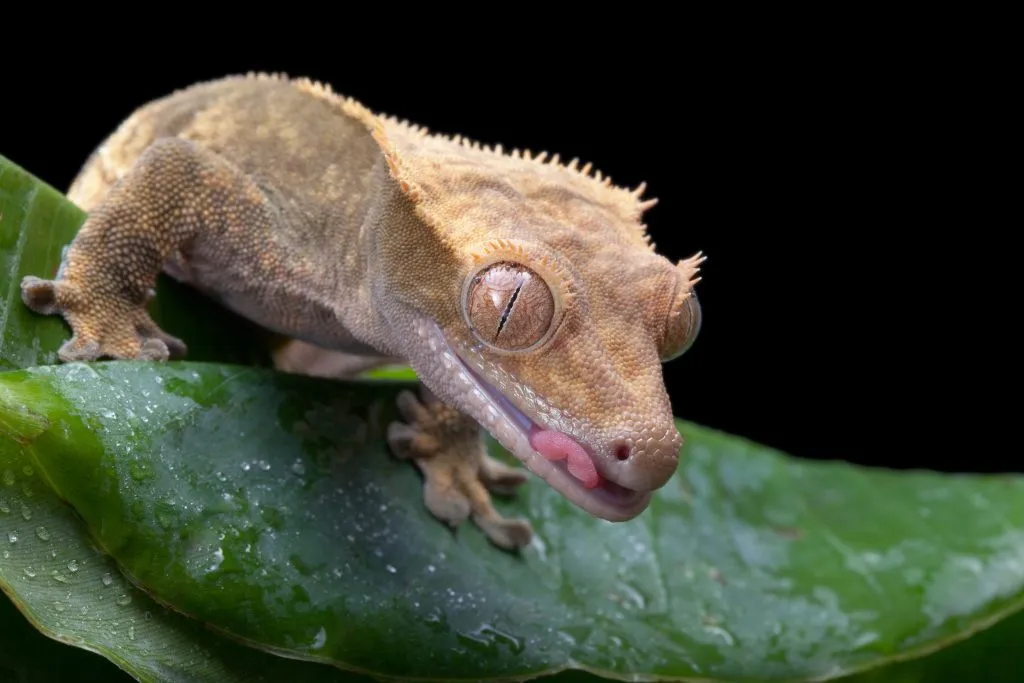
No matter what substrate you use, crested gecko tanks should be spot-cleaned daily. However, full cleaning frequency depends on the substrate.
Tank floors that are covered in paper, tiles, or mats must be completely cleaned and disinfected once a week.
Other substrates such as moss/soil mix will need to be completely changed out monthly to prevent buildup of bacteria, fungi, and parasites.
Bioactive substrates can often go years without being changed out entirely, if done right. Surface litter such as moss or leaf litter will need to be replaced about every two months, and other organic materials replenished about once a year.
The décor in tanks with bioactive substrate still needs to be cleaned regularly, usually monthly. Remove
Plastic plants and furniture can be put in the dishwasher for cleaning but only if no dishwasher detergent is used.
When tanks and décor are cleaned, everything needs to be removed and cleaned with a reptile-safe disinfectant.
Rinse and dry all pieces before placing everything back in the
Crested Gecko Diet
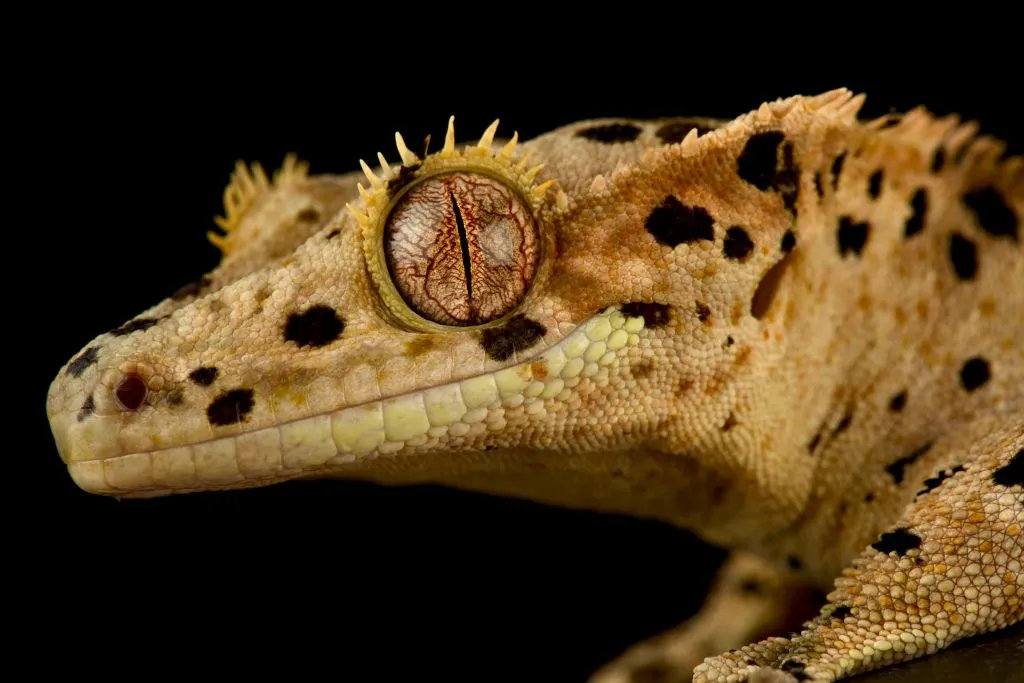
What To Feed
A wild crested gecko’s diet consists largely of insects and a small amount of fruit and soft seeds.
You can offer your pet gecko a wide variety of live insects, including locusts, snails, crickets, roaches, silkworms, butterworms, waxworms, and calcium worms.
All insects need to be a size appropriate to the size of the gecko – no wider than the width between the gecko’s eyes.
Also offer them a small amount of mashed fruits, such as pears, mangos, bananas, and strawberries.
Many crested gecko owners choose to feed their pets a commercial powdered premix. There are several available that are well-balanced to fully provide for the crested gecko’s dietary needs.
Examples of these include the Repashy Crested Gecko MRP Diet and the Pangea Fruit Mix with Insects.
These meal replacement diets are very convenient and highly palatable to crested geckos. Just mix the shelf-stable powder with water until it is the consistency of ketchup and place in their
How Often To Feed
Baby crested geckos are fed daily, while juveniles and adults are fed every other day.
Place premix
Insects can be offered once or twice a week even when feeding a premix
How Long Can They Go Without Food ?
Crested geckos can live up to three weeks without
Do Crested Geckos Need Water?
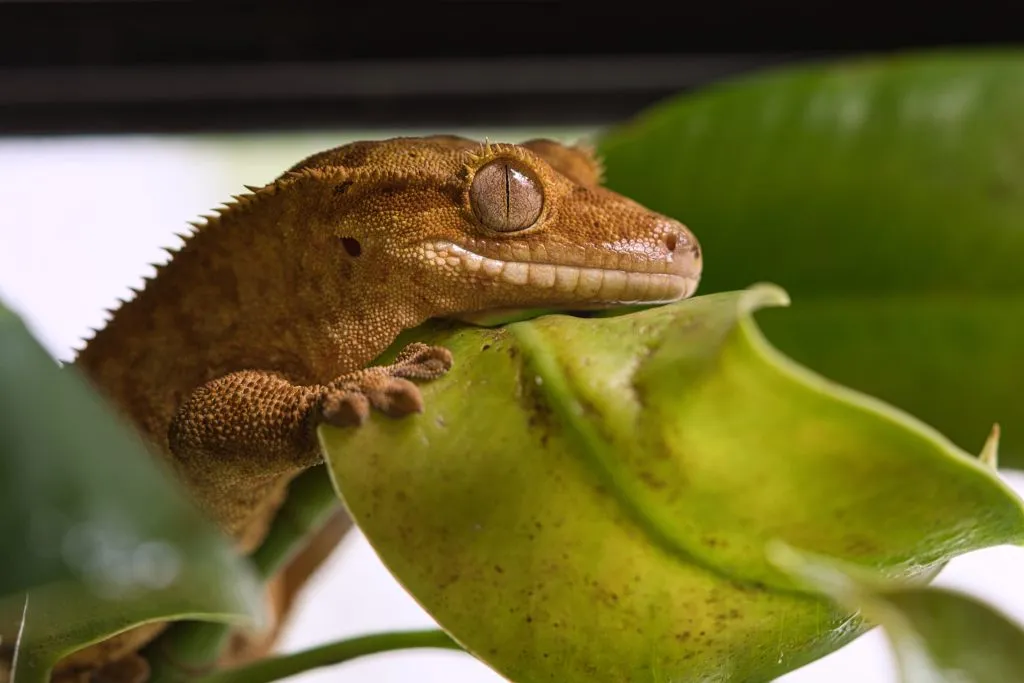
Crested geckos need water; however, they do not normally drink water from a dish. They like to get their water from droplets that accumulate on plants and other surfaces in their enclosure.
It is important to mist their
Vitamins and Minerals
There is a wide range of vitamins and minerals that are important for your crested gecko’s health. Premix meal replacement diets contain all the nutrients that geckos need, and no further supplementation is needed.
However, if you are feeding a diet of insects and fruits, then supplementation is definitely needed.
You will need to provide calcium by dusting feeder insects with calcium powder and making sure the insects are gut-loaded with a vitamin supplement before feeding.
Crested Gecko Behavior and Temperament
Crested geckos are crepuscular, meaning they are primarily active at dawn and at dusk. So you are not likely to see them moving about during the day.
These reptiles are relatively docile and slow-moving, although they can move quickly when they need to – such as when they are hunting their prey!
They are also rather shy and skittish and do not like being handled. If they feel threatened they are likely to drop their tail. Crested gecko tails do not grow back.
Are Crested Geckos Good Pets For Beginners?
Crested geckos are a good pet for first-time reptile owners as they are easy to feed and care for.
They can be good pets for children for this reason, as long as the child understands that the gecko is not to be handled or played with.
Do Crested Geckos Like Being Handled?
This shy, timid animal does not like to be handled. It is best to avoid handling crested geckos if at all possible. Your crested gecko is not a pet that you can cuddle and play with.
Crested Gecko Common Health Problems
Although crested geckos are fairly easy to care for, they are prone to certain health issues. Here are some to the common ones to watch for:
- Impaction – This is caused by eating things that can’t be digested, such as habitat sand or
food that is too big for their small digestive system. Weight loss, constipation, and lack of appetite are some signs of impaction. - Internal parasites – Symptoms include lethargy, weight loss, not eating, and vomiting.
- Respiratory infection – Crested geckos are prone to getting pneumonia if their habitat temperature and humidity are not optimal. Symptoms include lethargy, not eating, and open mouth breathing.
- Shedding problems – This can be largely prevented by having proper humidity in the
tank and providing a damp hide box that they can go to. - Tail shedding – Crested geckos will drop their tail if they feel threatened, and it will not grow back.
- Metabolic bone disease – This is caused by not getting enough calcium and/or vitamin D3 in their diet, which leads to soft bones. Visible symptoms are difficulty lifting their body up and limbs that are deformed.
Always contact a veterinarian if you have any concerns about your crested gecko’s health.
Where To Buy Crested Geckos
We always recommend that you look for a local breeder in your area whenever possible. This allows you to see their animals and make sure they are healthy before you buy. But if that is not an option, there are a number of online sources as well.
- MorphMarket – This is not a breeder, but rather an online site that connects buyers with breeders. Make sure to check out breeder’s ratings before you buy.
- Tiki’s Geckos – A highly rated breeder of crested geckos.
- All Reptiles – A Canadian-based breeder that is also highly rated.
Crested Gecko Price

The selling price of crested geckos starts at around $50 USD for the most common morphs and goes up from there.
The average upper range is about $250, for less common morphs. However, rare or “designer” morphs will set you back a lot more – up to $5000 for the really rare ones.
Crested Gecko Breeding
Females must weigh 40-45 grams before breeding, while males can be slightly smaller. The females will be mature and ready to breed at about 1.5 years of age. Males, on the other hand, might not be ready until two years of age.
Once introduced to each other, breeding pairs should be kept together all the time. Do not separate them after breeding.
Crested geckos can also be kept in “mating groups”, which can include multiple females but must have only one male.
Breeding and raising crested geckos can be interesting and fun. But there is more to it than just having a male and female that are kept together.
Watch the video below if you are interested in learning more about breeding crested geckos.
The Final Word
Crested geckos can come in a range of prices and a wide range of color and pattern morphs, so you are sure to find a morph that is perfect for you.
They are a unique and interesting pet that is suitable for beginners and more experienced reptile owners as well.
Crested geckos can make amazing pets if you provide them with the care and attention they need. With love, patience, and plenty of TLC your crested gecko will provide many years of fun and entertainment.
- Enchi Ball Python: A Unique and Stunning Morph of Python regius - March 27, 2025
- Emerald Tree Monitor: The Enigmatic Green Guardian of the Rainforest - March 26, 2025
- The Egyptian Cobra (Naja haje): A Fascinating Serpent - March 25, 2025
